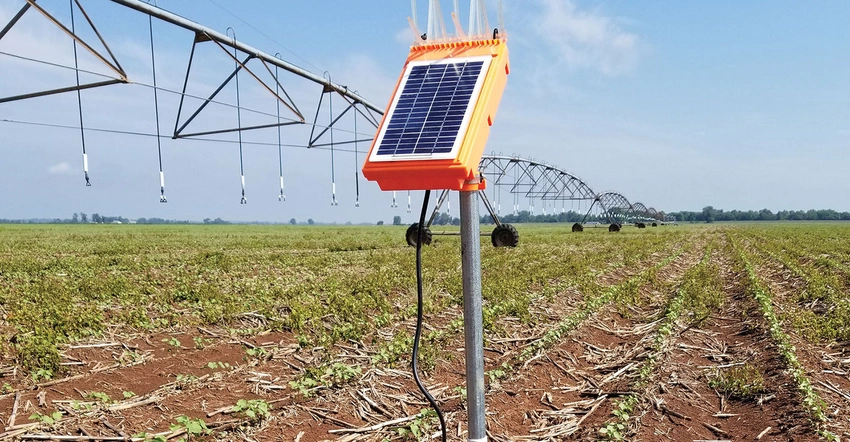Farm Irrigation Efficiency
Farm irrigation efficiency technologies aim to optimize water use in agriculture, reducing water waste and greenhouse gas emissions. These solutions are crucial for sustainable farming and climate change mitigation.
 An Aquaspy tube-style sensor - farmprogress.com
An Aquaspy tube-style sensor - farmprogress.com
job openings
View open jobs in this Solution
Example Companies
- N-drip - N-Drip is an agritech company that develops gravity micro-irrigation system to reduce water use in agriculture.
- Aquaspy - Develops soil moisture sensors and irrigation management solutions.
- N-drip - Develops gravity micro-irrigation systems to reduce water use in agriculture.
- Netafim - Specializes in precision irrigation systems.
- Jain Irrigation - Provides advanced irrigation technologies and solutions.
- Lindsay Corporation - Offers irrigation systems and water management solutions.
- Valmont Industries - Manufactures irrigation equipment and technology.
Overview
Significant advancements in farm irrigation efficiency have been made to reduce water loss and greenhouse gas emissions. Technologies such as drip irrigation, precision agriculture, and no-till farming play a vital role in achieving these goals.
Learn More
- Sustainable Fertilizer: Reducing hunger and pollution at the same time - Climate Tech Distillery
Progress Made
Notable advancements in farm irrigation efficiency for climate change include:
- Drip Irrigation: Reduces water loss and greenhouse gas emissions.
- Soil Moisture Sensors: Monitor soil moisture levels to optimize irrigation.
- Precision Agriculture: Uses technology to optimize water use and crop yields.
Solutions by Sector
Drip Irrigation
- Subsurface Drip Irrigation: Delivers water directly to the root zone, minimizing evaporation.
- Surface Drip Irrigation: Uses emitters to deliver water to the soil surface.
- Micro-Irrigation: Involves small-scale irrigation systems for precise water delivery.
Case Studies:
- Netafim, Israel: Pioneers in drip irrigation technology, improving water use efficiency (Netafim).
- Jain Irrigation, India: Implements advanced drip irrigation systems to enhance crop yields (Jain Irrigation).
- Lindsay Corporation, USA: Provides innovative irrigation solutions for sustainable farming (Lindsay Corporation).
Precision Agriculture
- Soil Moisture Sensors: Devices that monitor soil moisture levels to optimize irrigation schedules.
- Remote Sensing: Uses satellite or drone imagery to assess crop health and water needs.
- Variable Rate Irrigation: Adjusts water application rates based on soil and crop conditions.
Case Studies:
- Aquaspy, USA: Develops soil moisture sensors and irrigation management solutions (Aquaspy).
- Trimble Agriculture, USA: Offers precision agriculture tools to optimize water use (Trimble Agriculture).
- John Deere, USA: Provides advanced precision agriculture technologies for efficient farming (John Deere).
No-Till Farming
- Cover Crops: Planting cover crops to improve soil health and water retention.
- Crop Rotation: Alternating crops to reduce soil erosion and improve fertility.
- Residue Management: Leaving crop residues on the field to reduce evaporation and improve soil moisture.
Case Studies:
- Conservation Technology Information Center, USA: Promotes no-till farming practices to improve soil health (CTIC).
- National Resources Conservation Service, USA: Supports no-till farming through technical assistance and funding (NRCS).
- Environmental Defense Fund, USA: Advocates for sustainable farming practices, including no-till farming (EDF).
Lessons Learned
- Significant Impact: Farm irrigation efficiency has a notable impact on reducing greenhouse gas emissions.
- Early Development: Technologies are still in early development stages with challenges.
- R&D Investment: Continued research and development are needed for advancement.
- Learning from Successes and Failures: Important to learn from both successes and failures in implementation.
Challenges Ahead
- High Initial Investment: The cost of implementing advanced irrigation technologies can be high.
- Lack of Awareness: Farmers may not be aware of the benefits and potential of efficient irrigation technologies.
- Standardization and Affordability: Need for standardization and making technologies more affordable.
Best Path Forward
- Raise Awareness: Educate farmers about the significance of irrigation efficiency.
- Financial Incentives: Provide financial incentives for adopting efficient irrigation technologies.
- Invest in R&D: Enhance research and development to improve irrigation efficiency technologies.
- Develop Tools and Guidelines: Create tools and guidelines for assessing and improving irrigation efficiency.
Image credit: farmprogress.com